Nearly everyone needs some sort of customization to get the maximum performance and comfort out of a ski boot. Some folks always need a lot of tweaking, some need very little, and the boot that we tend to buy is the one that requires the least amount of adjustments to make fit.
Fit is a simple three letter word but there are a lot of things that need to mesh together well to get even an acceptable fit. If you want long term comfort and high performance, more things need to align well. Then add in the special requirements of backcountry skiing where the performance of a boot is intimately tied to its walking comfort as well as a firm delivery of leg power and you have a very tall order to fulfill.
Certified podarthist Bob Egeland in Boulder, Colorado has been in the boot fitting business for over 30 years. He boils it down to a three step process.
Step 1
First you need to get the proper boot environment, meaning the shape of the shell needs to conform to your foot. It needs to have enough length to fit your foot without scrunching up your toes or allowing your foot to move fore and aft while being just the right width to hug your forefoot without cramping it, and again, wide enough to hug your heel without squishing it or letting it slop from side-to-side as well as the volume of your foot, not just width, but the height of the instep (above the navicular zone).
Step 2
Step two helps stabilize the foot inside the boot. There is a combination of having the right shell size and shape to hold your foot, and the right foundation for it to rest on – also known as a proper footbed. The correct footbed, aka an insole, accounts for your unique anatomy by supporting your natural arch in a way that is comfortable and provides proper support for when you’re driving a hard turn. In addition, it must cup your heel so your calcaneous bone is held firmly in place to allow all the forces from your lower leg and forefoot to be transferred completely.
Step 3
Finally there is the process of molding the liner as an interface between your foot, footbed, and the shell so there is no slop between your foot and the shell. This final step may also involve modifications to the shell such as punching out a zone, grinding, or padding various regions of the liner. A good boot fitter makes all the difference at this stage.
Footbed – Getting Proper Support
Embedded in step two is optimizing the foundation your foot rests on, or the footbed. Your foot goes through a natural progression of pronating while pushing forward in the middle stages of a step, to suppination at the end. Some degree of pronation occurs when flexing the foot and driving forward, but too much pronation and your arch may collapse with a simultaneous shift to the side in the ankle. The result is a poor transfer of power and reduction in control. Over time ligaments can become strained, or predisposing you to injury.
There are several companies that make off the shelf, orthotically customized footbeds that support a variety of feet, and many options for the most common arch height, which is better than the filler footbeds nearly every company provides. In terms of support, unless the footbed has a heel counter to anchor its contours, it doesn’t do much for improving your foot’s support since it can roll from side to side.
Over the next few weeks I’ll add more details below to some of the standard, and not so standard options from companies that offer footbeds worth considering.
Recommended Footbeds
Aetrex
After several years diagnosing foot problems and prescribing custom orthotics Aetrex knew there were several common shapes, for the bottom of feet, but the alignment of the foot might need to be adjusted as well to provide optimal support. As a way to diagnose alignment they began recording pressure profiles under their patients feet. With a database of several hundred thousand feet they saw direct correlation with the many footbeds they made. The result is a selection of over 48 different footbed shapes that are recommended based on your unique pressure map. (Aetrex Testimonial)
EZ-Fit/Masterfit Footbeds
These are the footbeds developed by the brains behind Masterfit University the traveling road show of how to techniques for helping skiers get a great fitting ski boot. One of the results has been the development of the EZ Fit footbeds that abide by one of the guiding principles of Masterfit, to accommodate the shape of a foot, not necessarily correct it. Correction remains the domain of a podiatrist, but there’s no reason not to provide good support. In the case of EZ Fit footbeds, they come in two, trim-to-fit models. Both fit a medium to low arch with a firm heel cup that includes a center pad of foam for cushioning. They accommodate by “self-adjusting” through the relaxation of dimples in the post material under the arch. If the arch is too high for your foots shape, over time these dimples will be pressed out, relaxing the support of the arch, and allowing it to collapse a little. In the short run, they let the arch be supportive, yet forgiving, allowing for the change in shape of a flexible foot.
Sole
As with other footbeds, there is a range of options available, from insulated to cooling, but the common thread among Sole footbeds is a higher than average arch height out of the box. Over time the arch will relax, or you can accelerate that by heating the footbeds to mold them, but then you will be molding your footbed to a weighted foot. Sole’s footbeds come with a solid heel post so your foot won’t be tempted to rock from side to side when in a ski boot liner. They also make a nice line of sandals with low arch support, but that’s a lot more than you get with most sandals.
Spenco
Dr. Spence was a podiatrist who saw many patients looking for relief from foot pain. In his experience he saw many of the same issues and developed a line of footbeds to conform to the most popular shapes he prescribed for his patients.
Besides footbeds, and the best evidence I have that these provide adequate support is their incorporation in a line of sandals. Without a doubt the Spenco sandals I’ve been wearing over the summer are hands down the most comfortable sandals I’ve ever worn. I only wish the sandals had a higher arch like they offer with some of their footbeds. The arch height for most of their footbeds is low to medium height. If you want high arch support, customs are available.
Superfeet
These are the grandaddy of off the shelf footbeds. They’ve been around since the early 1980s. The core premise of Superfeet is to provide a stable platform for your foot by making sure the heel is well held with a heel post that cups your heel. The net effect is to anchor your entire stance and use the fatty tissue under your heel to provide cushioning. There are various models with different heights of arch support, and components to insulate, heat, or cool your feet, depending on the application. With qualified bootfitters it is also possible to get a custom Superfeet footbed.
© 2012
Related Links
Ski boot sizing chart

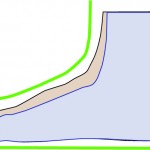
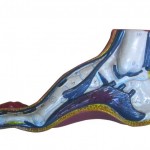
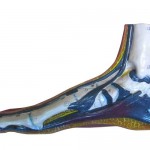
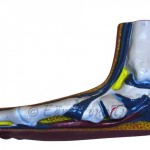
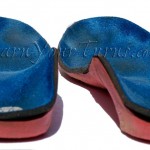
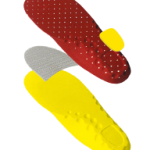
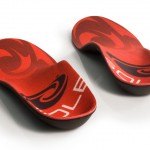
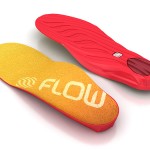
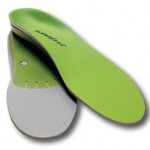
6 comments
1 ping
Skip to comment form
Have you ever heard of putting a footbed under the liner? I had a friend once with that setup (and having foot problems) and he thought he was told by the bootfitter to do that but I was pretty sure he was mistaken.
Sounds like bogus advice to me as well. It is common practice to put a footboard under a liner to help take up excess volume for those with a low instep in a shell made for a high instep, but not putting the footbed under the liner. That would pretty much negate any value the footbed was supposed to provide. Am guessing that was a misunderstanding.
+1 to getting a good podiatrist to tweak your boot, liner and footbed.
Quote: “off the shelf, orthotically customized footbeds” – sounds like a contradiction to me.
Feet can change over time too. In the course of a tour, with more weight on the back or more heat in the boot, they spread. Or as you get older, tendons and ligaments stretch and what worked last season may feel like a vice this season.
A downhill walking exit in otherwise good fitting boots/liners makes altogether new demands on the fit.
In short, boot fit is a WIP.
re: contradiction in terms…off the shelf, orthotically customized foodbeds. Good catch. Meant to say off the shelf footbeds that have a genesis, or heritage that came from a custom orthotic design. Footbeds like Aetrex is offering are preformed to a common shape based on an orthotic condition and thus are off the shelf. Hope that clarifies my jumbled communication above. 😉
No drama Dostie.
On US forums I read a lot of folks putting their trust in a good bootfitter. And that’s great if there’s a good outcome.
I love my podiatrist cos with feet changing, there’s little give in thermoliners and plakky boots but with a bit of tweaking of liners and std footbeds he keeps me going.
Eg. a heated spoon to get more toe width in the liner, or a minor build up in the footbed arch and some shaving off of it under the toe to get more length (pushes the arch up, drops the toes = toes pulled back). Simple intervention that works.
re: Bootfitting is a work in progress. Indeed! Am training to become a bootfitter at the local shop with a solid reputation for superb boot fitting. One of the reasons they have that reputation is they encourage folks to come back within the first year for “free” customizations. There are, of course, limits to that, but for 90% of the refinements people need they do there is no charge. They also do it because they know it is tough to catch every little thing in one sitting, AND it take some ski time to know where all the trouble spots are AND liners pack out AND feet change. So yeah, it is definitely a WIP.
[…] of Masterfit Enterprises, the business that runs the ABB boot test and makes products like EZ Fit footbeds, and Masterfit University, a traveling roadshow of seminars that help novice and experienced boot […]